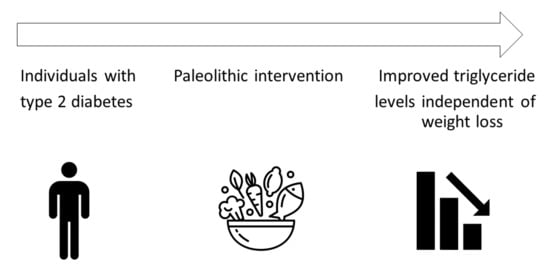
I en studie från Umeå universitet på paleo-kost (stenålderskost) minskade nivån av blodfetter i form av triglycerider (höga triglycerider är ett tecken på ohälsa. Lyssna på avsnitt 139 och 140: https://4health.se/140-kolesterolvarden-statiner-och-hur-du-forbattrar-dina-kolesterolvarden ) hos överviktiga personer med typ 2-diabetes. Detta skedde oberoende av viktnedgång.
Fördelarna med en paleo-kost på just triglycerider är att den innehåller mindre snabba kolhydrater, som är det som i huvudsak höjer triglycerider. Forskarna tror dessutom att det kan bero på uteslutande av mejeriprodukter.
Ju mer åt paleo-hållet man åt, desto mindre kroppsfett, bättre BMI, midjemått, blodsockernivåer och triglycerider.
Man definierade paleo så här:
Foods considered Paleolithic were lean meat, poultry, fish, seafood, fruits, nuts, berries, seeds, vegetables, and water to drink; “not Paleolithic” were legumes, cereals, sugar, salt, processed foods, and dairy products.
Ur studien:
This study is a secondary analysis of a randomized controlled trial using Paleolithic diet and exercise in individuals with type 2 diabetes. We hypothesized that increased adherence to the Paleolithic diet was associated with greater effects on blood pressure, blood lipids and HbA1c independent of weight loss. Participants were asked to follow a Paleolithic diet for 12 weeks and were randomized to supervised exercise or general exercise recommendations. Four-day food records were analyzed, and food items characterized as “Paleolithic” or “not Paleolithic”. Foods considered Paleolithic were lean meat, poultry, fish, seafood, fruits, nuts, berries, seeds, vegetables, and water to drink; “not Paleolithic” were legumes, cereals, sugar, salt, processed foods, and dairy products. A Paleo ratio was calculated by dividing the Paleolithic calorie intake by total calorie intake. A multiple regression model predicted the outcome at 12 weeks using the Paleo ratio, group affiliation, and outcome at baseline as predictors. The Paleo ratio increased from 28% at baseline to 94% after the intervention. A higher Paleo ratio was associated with lower fat mass, BMI, waist circumference, systolic blood pressure, and serum triglycerides at 12 weeks, but not with lower HbA1c levels. The Paleo ratio predicted triglyceride levels independent of weight loss (p = 0.046). Moreover, an increased monounsaturated/saturated fatty acids ratio and an increased polyunsaturated/saturated fatty acids ratio was associated with lower triglyceride levels independent of weight loss. (p = 0.017 and p = 0.019 respectively). We conclude that a higher degree of adherence to the Paleolithic diet recommendations improved fat quality and was associated with improved triglyceride levels independent of weight loss among individuals with type 2 diabetes

Lämna ett svar